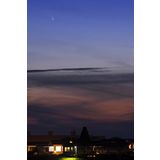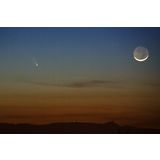
Explore the starry skies of April! There will be a number of intriguing celestial sights to enjoy during April with the help of a binocular and/or telescope, but there will also be a few events you can enjoy with unaided eyes. As the Year of the Comets continues, astronomers are hopeful April will present good viewing opportunities for Comet PANSTARRS and Comet Lemmon. Here are a few of Orion's top picks for April stargazing:
Catch Comet PANSTARRS — While not as bright as expected, Comet PANSTARRS is still putting on quite a show in the night sky. In April you'll need 50mm or larger binoculars, or a telescope to get the best views of this cosmic traveler as it races out of our Solar System. An especially awesome sight will occur on the nights of April 3rd and 4th, when PANSTARRS will glide within 2° (about 4 lunar diameters, or "Full Moon widths") of M31, the Andromeda Galaxy! Use 50mm or larger binoculars or a wide-field telescope to get the best view of this once-in-a-lifetime event.
Rise Early for Comet Lemmon — If you rise before dawn in April, you'll have a chance to see a second bright comet, Comet Lemmon. By mid-month this comet will be low in the southeastern dawn sky, and it will get higher with the passing days. This comet is expected to fade significantly by May, and it will then likely require an astrophotography setup to capture an image of it. So take advantage of pre-dawn viewing opportunities in April! Learn more about when to see Comet Lemmon in this informative article.
A Great Month for Star Parties! — With the New Moon occurring on Wednesday, April 10th, the prior weekend of April 6th and 7th, and the following weekend of April 13th and 14th both present great stargazing opportunities. Since the Moon will be relatively dim on these weekends, they will be great times to organize star parties and search for and explore faint Deep Sky Objects with friends and family!
Challenging Meteor Shower — On April 21st, the April Lyrids Meteor Shower will occur, but unfortunately this popular perennial event will share the sky with a waxing Moon, which will reach Full Moon phase on April 25th. The glare of the bright Moon will hamper meteor observations, but it will still be worthwhile to sit back in a comfy chair and try to sight meteors as they appear to radiate from the constellation Lyra in the northeastern sky.
Binocular Bounty — Use 50mm or larger binoculars in April to explore our personal favorite constellation — Orion! The entire constellation is a treasure trove of celestial sights, but we especially enjoy observing M42, the Orion Nebula, with big astronomy binoculars. For even better observations of this cloudy nebula, use a 6" telescope with a wide-angle, low-power eyepiece to obtain a nicely framed view of this stellar nursery where stars are formed.
Last Call for Giant Jupiter — By mid-April, Jupiter will be approaching the horizon about 9pm, but the gas giant will still be high enough in the sky beforehand for some respectable views. Bigger refractor and reflector telescopes and moderate to high power eyepieces will deliver the most rewarding views of Jupiter before it leaves the night sky for the season.
Spring Brings Galaxy Season! — April skies provide stargazers with ample opportunities to observe far-off galaxies. With the Virgo Galaxy Cluster and bright galaxies in the Big Dipper and Coma Berenices well-positioned in the sky, April evenings are truly a gift for galaxy-hounds. Check out a few of our favorite galaxies: M101, M51, and M106 near the Big Dipper asterism; M86, M87, M84 and M104 in the Virgo Galaxy Cluster; and don't miss NGC 4565, M64, M99, and M100 in the constellation Coma Berenices. While a humble 80mm telescope will show most of the galaxies we mention, you can't beat a big 10"-16" reflector telescope for jaw-dropping views of these galaxies!
April's Challenge Object — You'll need a big reflector telescope to go after this month's challenge object, which is a group of at least six faint galaxies closely packed around NGC 2687, which lies about a degree northwest of Talitha, the southwestern "foot" of the constellation Ursa Major (which also is home to the Big Dipper asterism). This so-called "Kevin's Sextet" of faint galaxies is quite challenging to detect in telescopes, so we recommend using a 12" to 16" Dobsonian reflector to find out how many galaxies you can see.
All objects described above can easily be seen with the suggested equipment from a dark sky site, a viewing location some distance away from city lights where light pollution and when bright moonlight does not overpower the stars. All objects have been verified by actual observations by Orion Telescopes & Binoculars Staff at Fremont Peak State Park, and/or Deep Sky Ranch, 60 miles and 90 miles respectively from San Jose International Airport, San Jose, CA.




















